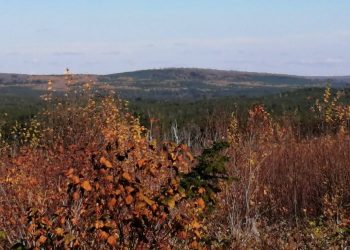Two respected environmental organizations have come out definitively opposed to the Northcliff Sisson mine proposed for the Upper Nashwaak Watershed. The Nashwaak Watershed Association and the Conservation Council of New Brunswick have both issued statements in opposition to the mine plan. The watershed association has further suggested that at a minimum the province should reset the Environmental Impact Assessment (EIA) of the mine to include updated building standards and updated consideration of the business case for the mine.
Recent research also points to a need for updated consideration of the health impacts of the mine. A recent NB Media Co-op story featured the work of researcher Dr. Daniel Saucier of the Centre de Formation Médicale du Nouveau-Brunswick and his associates who have documented a possible connection between the spatial distribution of the incidence of Amyotrophic Lateral Sclerosis Disease (ALS) and the prevalence of past sulfur dioxide emissions in the province.
ALS is a fatal motor neuron disease causing progressive degeneration of nerve cells in the spinal cord and the brain.
While the study by Dr. Saucier and his associates concluded that more research is required to pin down a causal relationship between ALS and sulfur dioxide, the report of abnormal per-capita incidence of ALS in the province relative to the national average is cause for alarm, concern and caution. Quoting the article: “preliminary analysis, published in 2016 found an annual rate of 2.5 cases annually per 100,000 people in New Brunswick. In contrast, most countries around the world typically see one or two cases per 100,000 people.”
By comparison and closer to home, the journal Neurology has reported the incidence of ALS in heavily industrialized southwestern Ontario, 1978 through 1982, as 1.63 per a population of 100,000.
Given the results of this ALS study, further investigation has unearthed a possible link between ALS and other compounds of interest to New Brunswickers. A quick search of the scientific literature reveals a connection between ALS and the compounds, hydrogen sulfide and ammonia, two compounds scheduled to be in use and emitted from the Ammonia Para Tungstate (APT) processing plant at the proposed Sisson mine.
While all these studies are in the early stages of confirmation, their results suggest a need for a more proactive approach to Health Impact Assessment of the proposed Sisson mine before the project is permitted to proceed any further. Given the findings of the late Dr. Eilish Cleary’s 2012 report on shale gas, at a bare minimum the residents of the Nashwaak watershed require and deserve a thorough baseline assessment of health conditions, air quality, soil conditions and water conditions before this mine is permitted to release these toxins onto the landscape.
Also of note:
- The current mine plan is based on outdated Best Available Practices and Best Available Technology of tailing storage and dam design. We would not allow residential or other industrial construction to proceed in 2025, based on outdated building codes of 2013, and based on an excuse that it would be too expensive to build to current code standards.
- The current mine plan is based on outdated economic feasibility studies. Operating costs and capital costs of mines have outdistanced metal prices. Staking the province’s future on 2011 economic data is not an intelligent way to proceed in these economically challenged times.
- Critical Minerals researcher Cameron Stockman has pointed out that the Sisson mine would likely require a government guaranteed price floor, combined with government stockpiling of the mine off-take in order to attract the investment required to launch the project. This constitutes a tacit admission of the bad business case for this mine that is destined to suck on struggling taxpayers and to detract from “Nation Building” aspirations.
- The mine’s shaky business case is also destined to saddle the watershed and province with boom-bust cycles, accompanied by all the social turmoil that result from such cycles in today’s society. The social chaos of boom-bust is epitomized by the wave of drug culture murders in Dawson Creek, B.C. following a sudden boom in the oil and gas sector.
- The current mine plan is based on outdated models of air emissions. Current science has shown that past models of emission dispersion are inadequate. The residents, farmers, livestock, land, air and water of the Nashwaak watershed and the province deserve better protection from the arsenic, fine particulate matter, hydrogen sulfide and ammonia destined to come out of this mine.
- The current mine plan is based on archaic open-pit technology that is being replaced by less intrusive pin-point directed borehole drilling.
- The current mine plan is being driven by an influx of money from the U.S. military establishment with probable unspecified promises of guaranteed price and market for its output that will further burden taxpayers and the environment.
Given all the above considerations and that the mine proponent has failed to comply with several conditions of approval including refusing to provide the public with a model of a tailing dam failure and an appropriate financial securities plan for reclamation and water treatment post closure, it is time to pull the plug and call a halt to the proponent’s foot dragging. It is time to reset the whole EIA process on Sisson. The possible link of the proposed mine to the neurological disease ALS should be a tipping point for all New Brunswickers.
Stop the madness, listen to the water, consider the health of our children and future generations, and reject this blight on the landscape. The proponent has been allowed to play its investment games unimpeded for far too long.
Lawrence Wuest is an ecologist living in the Upper Nashwaak on unceded territory of the Wəlastəkwiyik, Mi’kmaq, and Peskotomuhkati.



![‘Continuum of genocide’: Pentagon funding of Sisson mine provokes renewed opposition from Wolastoq Elders [video]](https://nbmediacoop.org/wp-content/uploads/2025/07/SissonMine-2-350x250.jpg)
![Is pollution from industry causing the neurological disease ALS in New Brunswick? [video]](https://nbmediacoop.org/wp-content/uploads/2025/10/Quintin-Soloviev-Belledune_Generating_Station_in_New_Brunswick_Canada-350x250.jpg)

![Mi’kmaq senator pushing for end to ‘second-generation cut-off’ gains traction, but feds signal opposition [video]](https://nbmediacoop.org/wp-content/uploads/2025/11/S2Nov132205-2-120x86.jpg)



